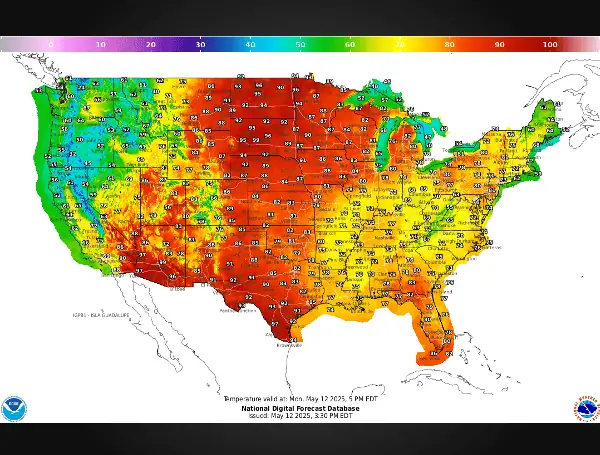Americans are facing a starkly divided weather pattern this week, with significant and contrasting conditions impacting different regions of the country. A slow-moving low-pressure system is poised to bring heavy rainfall and the potential for flooding to the East Coast, while parts of the Plains continue to swelter under record-breaking heat, increasing wildfire dangers.
Meanwhile, a strong cold front is ushering in a dramatic temperature drop across the West.
A well-defined closed low over the central Gulf coastal region is driving the potential for widespread heavy rains in the East. This system is expected to lift slowly northward over the next two days, moving across the Tennessee and Ohio Valleys and into the Lower Great Lakes.
READ: Parts Of North Carolina Brace For Flood Threat As Hurricane Helene Recovery Continues
The heaviest precipitation is anticipated on the eastern flank of this low, which will extend from Southeast Florida northward through the Mid-Atlantic, Southern to Central Appalachians, and Lower Great Lakes.
While these rains could benefit areas currently experiencing moderate to extreme drought, the slow movement of the storms and the potential for repeated rainfall over the same areas raise concerns for flooding and flash flooding. Urban areas in Southeast Florida and the Mid-Atlantic are particularly vulnerable, as are the higher terrain regions of the Southern to Central Appalachians.
Flood watches are currently in effect for parts of Southeast Florida, central Alabama, central North Carolina, and a large swathe of the Southern to Central Appalachians encompassing western North Carolina, western Virginia, eastern West Virginia, and far western Maryland, impacting nearly 20 million people.
READ: Living Strong: How Women May Maintain Bone Health And Prevent Falls
Scattered lighter to moderate showers are also expected from the Central Gulf coast through the Tennessee and Ohio Valleys and into the Mid-West, though widespread heavy totals are less likely in these areas.
In sharp contrast to the wet weather in the East, a significant cold front is pushing inland from the Pacific Northwest. This system is bringing much-below-average temperatures to central to Northern California and the Pacific Northwest today.
The cold air is forecast to spread southward into Southern California and eastward across the Great Basin and Northern Rockies on Tuesday, reaching the Southwest and Central Rockies by Wednesday. This marks a dramatic shift in conditions for these regions.
Simultaneously, much-above-average to record-high temperatures are expected to persist across large sections of the Plains into mid-week. Additional record highs are likely on Tuesday and Wednesday from the Dakotas into Minnesota, with heat also developing across portions of south-central Texas.
READ :“Gravy Train Is Over” Feds Subpoena California Immigrant Program In Major Welfare Fraud Hunt
The combination of this intense heat with gusty winds, dry conditions, and low relative humidity is creating elevated to critical fire weather threats.
Red Flag Warnings are currently in effect for large portions of the Northern Plains, Upper Mississippi Valley, Upper Great Lakes region, and parts of the Southwest, affecting over 10 million people. Residents in these areas are urged to exercise extreme caution regarding potential fire ignition sources.
Authorities advise residents in affected areas to stay informed about the latest forecasts and warnings from the National Weather Service and be prepared for rapidly changing conditions.
Please make a small donation to the Tampa Free Press to help sustain independent journalism. Your contribution enables us to continue delivering high-quality, local, and national news coverage.
Connect with us: Follow the Tampa Free Press on Facebook and Twitter for breaking news and updates.
Sign up: Subscribe to our free newsletter for a curated selection of top stories delivered straight to your inbox.

